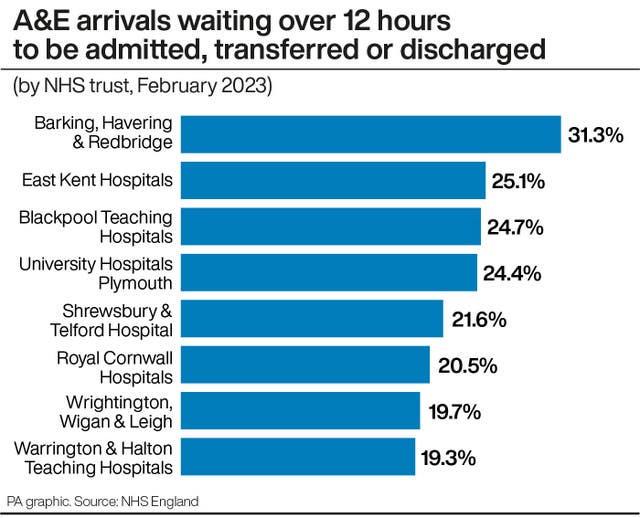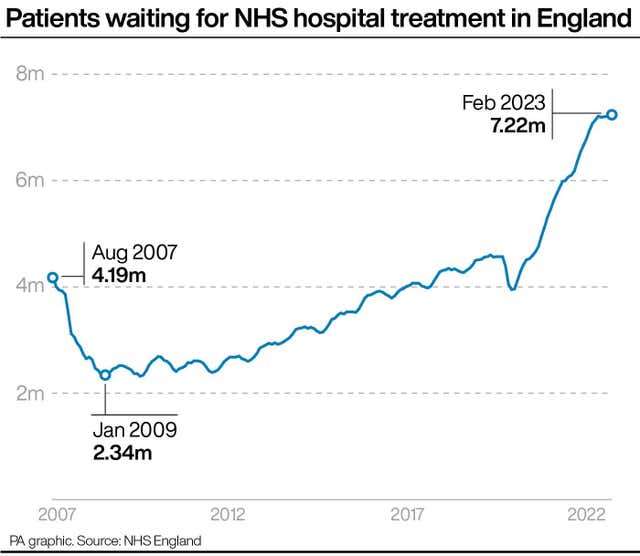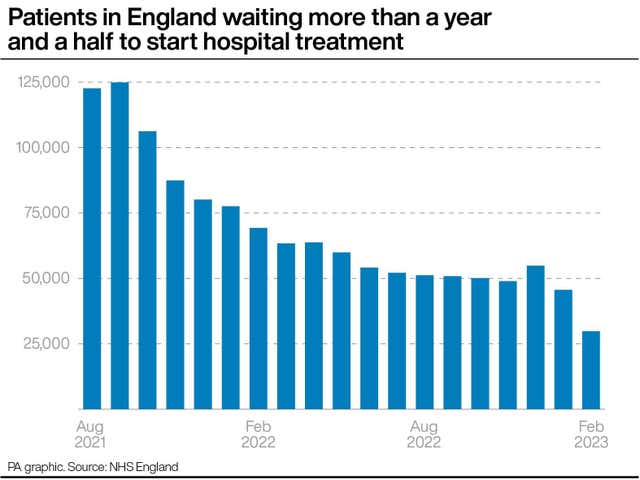One in 10 people waiting more than 12 hours from arrival at A&Es
The total waiting list for treatment in England has also hit a new record high.

Around one in 10 people arriving at major A&E departments in England are having to wait more than 12 hours before being admitted, transferred or discharged, new figures show.
At some NHS trusts the figure is close to one in five, while at two trusts – East Kent and Barking, Havering & Redbridge – the proportion is higher than one in four.
It is the first time data has been published that measures waits of more than 12 hours from the point of arrival at A&E, and comes as the overall waiting list for treatment in England has climbed to a new record high.
The number of people waiting more than 12 or 18 months for treatment has continued to fall, however.

Prime Minister Rishi Sunak has made cutting waiting lists one of his priorities for 2023, pledging in January that “lists will fall and people will get the care they need more quickly”.
Some 10.6% of arrivals at hospitals with major A&E departments in February had to wait more than 12 hours before being admitted, discharged or transferred – the equivalent of 125,505 people, according to figures from NHS England.
Barking, Havering and Redbridge University Hospitals recorded the highest figure at 31.3% of arrivals, followed by East Kent Hospitals (25.1%), Blackpool Teaching Hospitals (24.7%), University Hospitals Plymouth (24.4%) and Shrewsbury & Telford Hospital (21.6%).
By contrast, North Bristol and Royal Berkshire NHS trusts both recorded 1.3% and Guy’s & St Thomas’ in London just 1.1%.
NHS England committed to publish data on A&E waits of over 12 hours as part of its recovery plan for urgent and emergency care services, which was agreed with the Government in January.
Until now, figures have been available only for the number of people waiting more than 12 hours in A&E from a decision to admit to actually being admitted.
This figure stood at 39,671 in March, up 13% from 34,976 in February but below the record 54,532 in December 2022.
Miriam Deakin, director of policy and strategy at NHS Providers, the membership organisation for NHS trusts in England, said the new data on A&E waits was “a real concern” which reflects “the incredible demand-driven pressures on trusts”.

She added: “The NHS is under severe and unsustainable pressure. Persistent challenges across urgent care are hindering progress on ambulance response times and A&E waits.
“Trust leaders are desperately awaiting a long-term fully funded workforce plan, which should start to address staff shortages, exhaustion and burnout.”
Dr Tim Cooksley, president of the Society for Acute Medicine, said emergency care faces “extremely troubled times ahead” and the findings are “of grave concern.”
He added: “We are heading for extremely troubled times ahead in urgent and emergency care and this data is a warning of what is to come.
“Overcrowding in emergency departments (EDs) and acute medical units (AMUs) means many patients are still not receiving timely and high-quality patient care.
“Caring for patients in such inappropriate environments not only provides a poor and undignified patient experience, it poses significant risks including increased risk of severe, and sometimes fatal, harm.”
Dr Layla McCay, director of policy at the NHS Confederation, said pressure on the service continues to be “relentless”.
“The figures for 12-hour A&E waits from arrival show that too many patients are having to wait longer than NHS leaders would want or expect.
“This is an ongoing priority for NHS leaders and their teams and has been addressed following the steps taken in the recent urgent and emergency care recovery plan.”

An estimated 7.22 million people were waiting to start routine hospital treatment at the end of February, up slightly from 7.21 million in January and the highest total since records began in 2007.
The number waiting more than a year and a half has dropped from 45,631 to 29,778, a month-on-month fall of 35%, in fresh evidence that progress is being made on clearing the backlog of longest waits.
The Government and NHS England have set the ambition of eliminating all waits of more than 18 months by April 2023, excluding exceptionally complex cases or patients who choose to wait longer.
Waits of more than 52 weeks are down from 379,245 in January to 362,498 in February, with a target for eliminating them completely by March 2025.
The figures coincide with a period that saw a number of strikes by NHS workers in England, including two days of industrial action by nurses in early February and three days of localised strikes by ambulance workers later in the month.
Junior doctors in England are currently in the middle of a 96-hour strike in an ongoing dispute about pay.
Professor Stephen Powis, NHS national medical director for England, said: “The last few months have been demanding for the NHS as record numbers of patients have come forward for care on top of hugely disruptive strike action.
“Today’s data shows demand on services is not relenting, with A&E attendances and ambulance call-outs in March recorded at the highest level so far this year – even higher than a very busy January.
“But amid the demand and industrial action, staff have progressed on key NHS priorities, with the number of people waiting the longest for elective care continuing to reduce while for the first time ever the NHS has also hit the faster diagnosis standard for cancer – with more patients getting a definitive diagnosis or the all-clear within 28 days.”
The latest NHS performance data for England also show that:
– The average response time in March for ambulances dealing with the most urgent incidents, defined as calls from people with life-threatening illnesses or injuries, was eight minutes and 49 seconds, up from eight minutes and 30 seconds in February and above the target standard response time of seven minutes.
– Ambulances took an average of 39 minutes and 33 seconds last month to respond to emergency calls such as heart attacks, strokes and sepsis, up from 32 minutes and 20 seconds in February, while the target is 18 minutes.
– Some 229,721 urgent cancer referrals were made by GPs in England in February, up 1% on January and 4% higher than a year earlier, in February 2022.
– Just 58.2% of the 14,082 cancer patients who had their first treatment in February after an urgent GP referral had waited less than two months, up from a record low of 54.4% the previous month but well below the target of 85%.
There has been an improvement in the proportion of patients urgently referred for suspected cancer who were then diagnosed or had cancer ruled out within 28 days, up from 67% in January to 75% in February – the first time the target of 75% has been met.
Michelle Mitchell, chief executive of the charity Cancer Research UK, said: “While it’s promising that people are finding out if they have cancer faster, many still face record waits for vital treatment. Any cancer care target missed is a missed opportunity to save lives.
“A lack of long-term investment in the NHS workforce in England by the UK Government has left cancer services chronically understaffed and unable to meet rising demand. The current strike action by junior doctors is a worry for cancer patients and we urge all parties to work together to ensure that people don’t miss out on life-saving services.”





